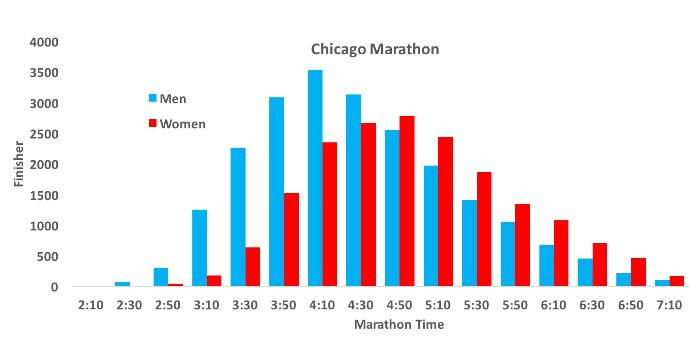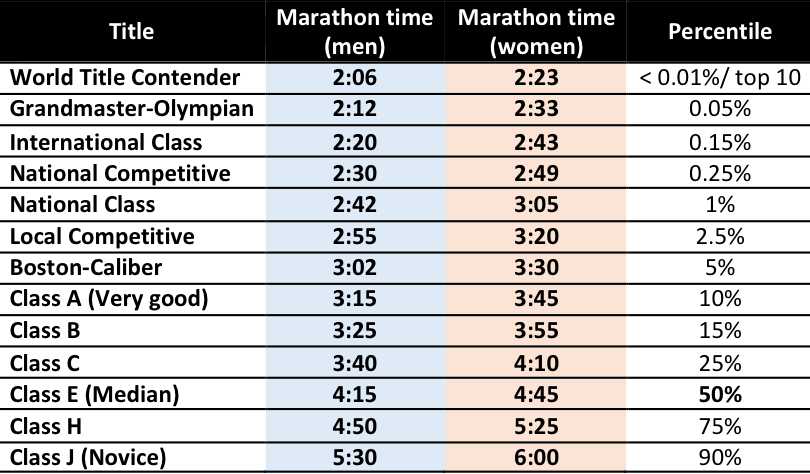Using the chess ranking system to categorize runners: What counts as elite?

We toss around words like elite, middle of the pack, sub elite, etc. But how can we define these when running has a lack of official categories?

There have been various times when I’ve been described as elite, sub-elite, elite-B, or in many cases a runner who happens to be near the front. I can run a 1:09 half and 2:35 full marathon– times that are fast enough to a win a local race, but let’s not kid ourselves: I could never win a championship event, men’s or women’s.
Category-wise, I’m not sure what to call myself. For a male runner who can run a 62-minute half or a 2:12 full, there’s no question that he has achieved elite status. And yet, those times wouldn’t be quick enough to win most high-level races. For that, you would have to run a 2:06, 2:05, or even faster marathon.
In running, there’s a lack of labels and categorization. Not all sports suffer from this ambiguity. Take baseball, where there is Major League Baseball, AAA, AA, Class A+, A, Rookie, and so on. Similarly, in hockey we have the NHL, minor AAA, AA, A, B, C, and various house leagues (which sometimes themselves get divided into A, B, and C levels!).
When first thinking about it, it may seem unnecessary to rank runners. One of the joys of running is that anyone can toe the line and be in the same race as world-class competitors. For a game of football or wrestling, it would be downright dangerous for amateurs to come face-to-face with the strongest players– a ranking system in these cases is absolutely necessary.
But, I can think of one type of competition that ranks, in detail, everyone from world class to recreational players: chess.
Enter the world of chess as it applies to running:
Chess players are ordered by the Elo rating system. The details aren’t important but in a nutshell, everyone receives scores based on past performances. Just like running a certified race course, anyone can obtain an Elo score after a few local tournaments. Players can get scores ranging from 100 (the lower end), 1000 (average), all the way up to 2800+ (e.g. World Champion Magnus Carlsen).
Using the Elo system, you can see what percentile is given to chess players of all abilities. This gave me an idea. I wanted to compare these percentiles to marathon running performances. For example, an Elo score of 1001 puts you in the top 50 per cent of all players. Based on numbers from runningusa.org, median finishing time for male and female runners is 4:16 and 4:41, respectively.
Ranking runners by the Elo system:
The lowest Elo rank is “J” which puts you in the bottom six percentile. That’s equivalent to a 5:00 male or 5:30 female finishing time. Higher ranks earn you letters closer to A, and beyond. Special titles are reserved for those in the top one per cent. (Note that I did not subdivide for age categories. I recommend an age graded calculator to convert master’s times.)
For this exercise, I used data from the 2014 Chicago marathon to fill in various percentiles to apply the Elo system to running. This race hosts a large field of over 41,000 with 200 highly competitive runners. I found the finishing times in Chicago were similar to national averages and so it’s a representative sample.
For my purposes, I removed times that were slower than 6:30 since they might include walkers. Without further delay, here are the rankings in terms of percentiles:
The titles, adopted from chess, reflect various running skill categories. They represent the times required to fit roughly within each group. One intriguing note that came from the data is that the three-hour mark is a major achievement– both for men and women runners.

Men running a marathon in 3:00 or faster are ahead of about 95 per cent of the field, while the same time puts a woman in the top one per cent of her race. Meanwhile, a man who runs 3:40 and a woman who runs 4:10 place in the top quarter of their respective races.
At the other end of the spectrum, running sub-2:20 will place a man in the top five or ten fastest Canadian times for any given year. A sub-2:33 women’s time, such as that of Lanni Marchant and Krista DuChene (both accomplished last year) earn the title of Grandmaster.

Reid Coolsaet and Eric Gillis are then their male GM counterparts. This gives some context to the impressiveness of their accomplishments. Fun note: Since 1960, Canada has had 10 chess grandmasters. And the number of Canadian sub-2:12 (male) marathoners so far? Also ten!
Some might argue that many runners are not interested in their finishing times, so placing them in a table like this is unfair. But I have found survey data which indicates that over 85 per cent of marathoners do care what their time will be. Knowing too that 98 per cent of marathon runners finish the race, we might agree that most participants are dedicated to doing their best. The goal here is to give context to the word ‘elite.’ I have intentionally omitted the word elite in the above table, and left some other entries blank too. I encourage people to supply their own.


